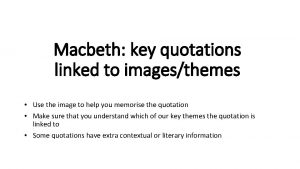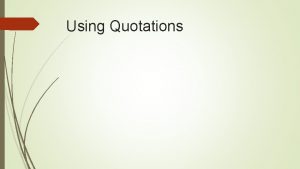Homework Key cards Key Words Key Quotations Starter











- Slides: 11

Homework : Key cards Key Words Key Quotations

Starter: key Word Bingo n n n n Teleological A priori A posteriori Inductive Deductive Theistic argument Analogical argument Empirical

n Chronology tsk

Lesson Aim n To learn about modern versions of the design argument.

Immanuel Kant, Critique of Pure Reason: “ This proof always deserves to be mentioned with respect. It is the oldest, the clearest, and the most accordant with the common reason of mankind”. Discuss and comment on the meaning of this quotation: Implication: Great appeal had attention paid to it in the contemporary period.

Modern versions of the Design Argument F. R. Tennant (1866 -1957) Philosophical Theology (1930) n It is possible to imagine a chaotic universe, where there are no rules. n The universe is evidently not chaotic. In fact, it appears to be designed to support life. Further, it appears to be beautiful at all levels. n Evolution itself proposed by biologists as an unregulated principle, in fact works to the advancement of species, supported by a world that provides all that is necessary to promote life.

n n n There is more to life than mere existence. Humans appreciate aesthetic activity, such as art, music, and literature. This is not necessary for mere survival, so cannot have come about through natural selection. Therefore, life as we know it is the product of a designing creator. This last part of Tennant’s argument is sometimes called the aesthetic argument. Tennant also formulated the Anthropic Principle or argument to design (the purpose of the universe’s existence is the support of human life – evolutionary theory strengthens this argument).

Richard Swinburne in The Existence of God (1979). n n n Attempted to defend argument from design in the contemporary period. The universe could easily be either ordered or chaotic. The fact that it appears ordered cannot be mere chance. It must therefore be a matter of probabilities. The sheer size of the universe makes it unlikely that it should just ‘happen’. Further, the universe appears to operate by a series of laws.

n n These laws do not account for the apparently ordered way in which the universe operates. “In scientific explanations we explain particular phenomena as brought about by prior phenomena in accordance with scientific laws… from the very nature of science it cannot explain the highest level laws at all; for they are that by which it explains all other phenomena. ” Swinburne, R. The Existence of God, 1979, p. 138

n Swinburne argued that the high degree of order that the universe demonstrates is evidence of a personal, conscious choice of God.

Colour coding: n n Pg. 20 -25 Tyler – or notes if done so. Update cards – 1 -2 quotations from Swinburne. - 2 key words: Aesthetic argument and Anthropic Principle. Read ahead pg. 17 -19 – Criticisms Dawkins/D. Hume/Problem Evil and Suffering/J. S. Mill. Evidence – update key cards – key word? 2 quotations key thinkers.
 Source note cards
Source note cards Wordle starter word
Wordle starter word Jack prelutsky homework oh homework
Jack prelutsky homework oh homework Homework oh homework i hate you you stink
Homework oh homework i hate you you stink Jack prelutsky homework oh homework
Jack prelutsky homework oh homework Homework oh homework i hate you you stink
Homework oh homework i hate you you stink Alitteration definition
Alitteration definition Homework oh homework i hate you you stink
Homework oh homework i hate you you stink Macbeth key quotations
Macbeth key quotations Quadrilateral task cards answer key
Quadrilateral task cards answer key Ice method for quotes
Ice method for quotes Framing quotations
Framing quotations




















